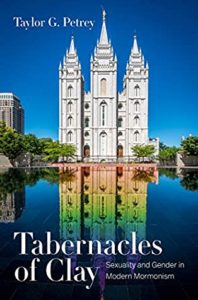 Author: Taylor Petrey
Author: Taylor Petrey
Title: Tabernacles of Clay: Sexuality and Gender in Modern Mormonism
University of North Carolina Press, 2020
(Reviewed by Erik Champenois)
Tabernacles of Clay covers the history of sexuality and gender in post-World War II Mormonism (specifically, in the Church of Jesus Christ of Latter-Day Saints), showing how church leaders have evolved in their understanding of sexuality and gender over the years. Instead of an unchanged and complete elucidation of gender and sexuality, the Church has evolved through conservative cultural influences and psychological approaches in its understanding of and teaching of gender and marriage.
Petrey’s approach is to elucidate the theoretical approaches behind LDS understandings of gender and sexuality first, and then to show how those approaches changed and evolved historically. Most fascinating, he shows how the concept of gender as an essential and unchangeable feature of one’s identity is a modern teaching of the Church that is itself opposed to prior church leader’s understandings of gender as well as in conflict with itself in the modern day Church. Former church leaders, for example, sometimes taught that gender was chosen by us as intelligences before becoming spirits in the pre-existence–and Joseph Fielding Smith even taught that those who are not saved in the Celestial Kingdom will become genderless. Today, the seemingly strong stance of the Church in favor of gender essentialism actually veils a practical belief in gender fluidity – gender is not so essential and unchanging that it doesn’t need to be protected. Rather, proper gender and gender relations need to be defended against their potential fluidity in the form of homosexuality.
The first chapter connects matters of race and gender in showing how LDS leaders enforced and defended an exclusivist sense of marriage vis-à-vis other types of marriages. In the early post-World War II era, the Church defended racially pure marriage against interracial marriages, but in the years after 1978 the Church downplayed (and eventually changed) its former stance against interracial marriages, now defending the sanctity of heterosexual marriage vis-à-vis same-sex marriage. It is interesting to consider the historical need of church leaders to defend itself against “an other” rather than to more inclusively value and defend all types of marriages.
The second chapter (“Sodom and Cumorah”) covers the Church’s adoption of psychological approaches to “cure” homosexuality. The Church was heavily influenced by conservative cultural and psychological approaches in its treatment of “homosexuality” (which as an adjective was preferred to the noun “homosexual”). When the American Psychological Association removed homosexuality from its list of mental disorders in the 1970s, Spencer W. Kimball and other church leaders were influenced by conservative critics to keep considering homosexuality a disorder and to attempt to cure it. Petrey shows how this approach relied on the concept of homosexuality as a form of gender failure – the cause usually being thought to be the absence of a strong father figure and a psychological need to compensate by bonding more closely with other males. Needless to say, the decades since have shown just how terribly wrong this approach has been and how damaging the Church’s adaptation of outdated conversion therapies has been to LGBTQ members.
Chapter three covers the Church’s defense of patriarchal marriage versus more equitable marriage arrangements, including the Church’s opposition to the United States Equal Rights Amendment (ERA). Paradoxically, the Church’s opposition to the ERA took place at the same time the Church transitioned its own teachings from being more heavily in favor of patriarchal marriage to moving towards a form of soft egalitarianism where husband and wife are theoretically (nearly) equal, with the husband’s “presiding” authority coexisting simultaneously with a more cooperative marriage partnership.
Chapter four covers the Family Proclamation and the Church in the 1990s to the 2000s, arguing that heterosexuality had now superseded patriarchy as the defining feature of LDS marriages. Petrey covers the Church’s history of political engagement in favor of traditional marriage and opposed to same-sex marriage, a story that has also been told well by Greg Prince in “Gay Rights and the Mormon Church.”
The final chapter of the book covers recent shifts in the Church’s understanding and teachings around homosexuality. The Church no longer supports conversion therapy, accepting that homosexuality cannot simply be “cured” – at least not in this life, as such a “cure” is still thought to take place in the after-life. Petrey also covers Elder Oaks’ admission that our understanding of transgender issues is incomplete and that “we have some unfinished business in teaching on that.” He covers other developments, such as the Church’s (short-lived) Exclusion Policy, Mormon and Gay website, and other outreach efforts, as well as the switch from defending traditional marriage politically to defending “religious freedom.”
Petrey’s book clearly shows how the LDS Church’s teachings on gender and sexuality are not rooted exclusively in scripture but are very much affected by cultural and historical currents. The book is richly grounded in the theory of not just sexuality but also gender, which makes this book even better and more complete than Greg Prince’s otherwise worthy companion book. Definitely a must read for anyone wanting to understand the history of gender and sexuality in the LDS Church.
